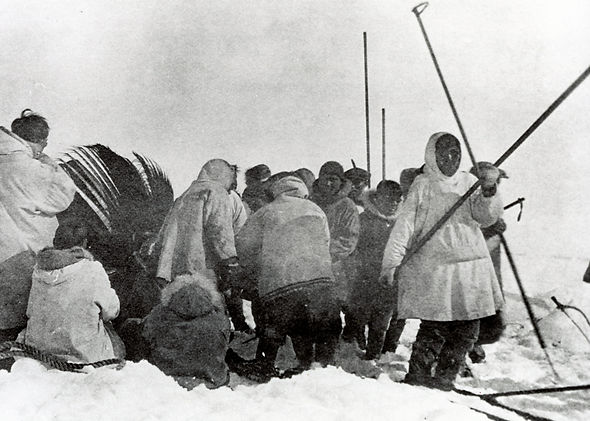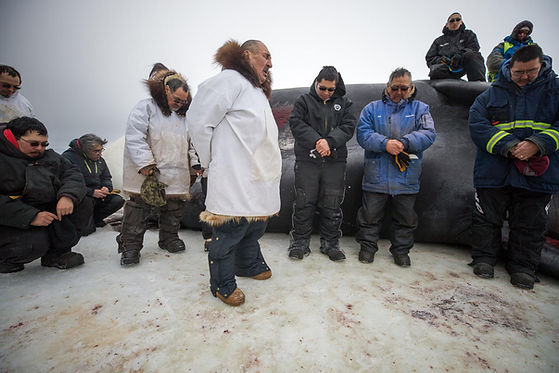
OUR STORY
Our culture is steeped in tradition with lessons passed down through generations from our ancestors. The harvest of the bowhead whale is central to our culture and our identities as ALASKA'S FIRST PEOPLE. It has been our primary food source for more than 2,000 years and remains a key nutritional resource for our 11 subsistence whaling communities.
In addition to its importance as a source of nutrition, the communal nature of the bowhead whale subsistence hunt makes it a critical activity for passing important cultural practices along to younger generations.
Whaling Captains are highly respected for their traditional knowledge of ice, weather, and whale behavior, which is necessary to hunt successfully. They are also known for their generosity in supporting their whaling crews, and for their stewardship of the Native traditions of sharing and distributing meat and muktuq throughout the communities. Of all subsistence activities in these communities, the bowhead whale hunt represents one of the greatest concentrations of community-wide effort and time and provides ongoing reinforcement of the traditional social structure. With all of this, the bowhead whale subsistence hunt is a key part, not only of the cultural traditions of northern Alaska’s Native communities, but also of their modern cultural identity.
.png)
Our culture is steeped in tradition with lessons passed down through generations from our ancestors. The harvest of the bowhead whale is central to our culture and our identities as Alaska's first people.
While we remain true to our traditions, we have also adapted to a changing world where today our greatest challenge is protecting our rights to feed our families and protecting the habitat of the whale that feeds them.
The AEWC was established in 1977 following a ban by the International Whaling Commission (IWC) on the harvest of bowhead whales by Alaska Natives. The ban was based on a report conducted without consultation with our hunters on the timing of the bowhead migration. Not surprisingly, the report estimated the Bering Sea stock of bowheads to be far less than its actual numbers.
Since its formation in 1977, the AEWC has advocated on behalf of the eleven whaling villages it represents to preserve the traditional subsistence hunt of the bowhead whales. This has included participation in meetings of the IWC, conducting scientific research on the bowhead whale stock and health, and improving the efficiency and humaneness of the bowhead harvest.

Whaling is vital to the sustenance of the Native people that inhabit the Arctic coast of Alaska. Just as they have for centuries, the whaling communities represented by AEWC rely on the bowhead whale for both the nutritional and cultural value they provide. These 11 coastal villages in northern Alaska are among the most remote in a land of harsh winters and environmental obstacles that most can not comprehend. Without access by road, each of these villages relies on the bowhead whale for a major portion of its food supply. Unlike the modern conveniences of the grocery stores that most people in modern society enjoy and take for granted, these villages typically have one general store with few options. The average price for a pound of meat (when it’s available) is approximately $10 to $12. Gasoline costs between $7 to $10 per gallon.
Compounding the problem of limited availability of supplies is the lack of jobs in these villages. With very limited employment opportunities, many people in the villages do not have the means to purchase groceries from the store. They rely on what they harvest from the ocean as the means to feed their families — importantly the bowhead whale. There are no other options for the survival of the people.
The bowhead whale is the thread that was spun thousands of years ago and has over the years woven together the fibers of the most ancient of Alaska’s civilizations, providing nutritional sustenance, cultural identity, and a means for survival. The Spirit of the Whale provides now as it did then for the Eskimos of the Arctic coast of Alaska.
